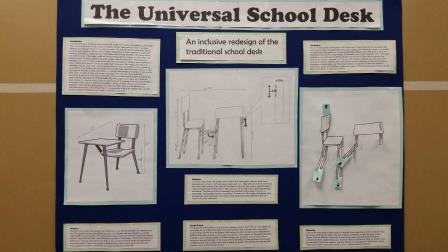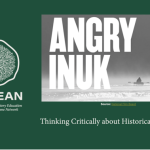
By Matina Broumas
Teachers are frequently thrown into situations where we must “make it work,” for such cases as new courses for which we may have inadequate (if any) background knowledge, lack of resources or support, or any number of other factors or variables. The Universal Design project was borne out of such a need to make the logistical reality of my own situation work for my students, and a pressure (mostly self-induced) to “get it right.” Little did I know that this would become a deep and authentic inquiry task, using minimal technology and a whole lot of mentoring.
It came at the end of a unit on Ableism in an HSE4M course that was newly introduced at my school. Early on, I decided to make the course more student-centred and project based. The challenge was to assess the kind of transformational learning I was hoping to achieve with my students, pushing students past pre-existing assumptions towards an openness to seeing issues through new perspectives. We learned terminology and theory, and found statistics on the state of diverse issues in our society, but the major learning came from various inquiries throughout the year.
The Ableism unit was scaffolded such that most of the direct instruction was front-loaded. The students learned and discussed the social construction of disability as well as various perspectives on it. We contrasted issues of media representation and the perpetuation of stereotypes with statistics and case studies on accessibility and Ontario’s labour force, leading to systemic barriers and unequal participation.
It was at this point that the Universal Design concept was introduced. Originating in architecture, UD principles have been applied to a myriad of contexts including education. Guided by these 7 principles, students were challenged to view their world more critically, to identify and propose potential redesigns, and to pitch the ideas to their colleagues.
As a teacher, I find that an interesting thing happens when I hand the reins over to students: some relish the thought of being in control of their own learning, while others demonstrate consternation over the seemingly endless and/or vaguely defined choices. To support the students as they ventured into unfamiliar territory, I presented a variety of UD case studies where access was improved in situations ranging from websites to Toronto storefronts.
Armed with this knowledge and considerable conference time with myself, students wrote short proposals. During this phase, students had to propose a topic and assess the original state of the issue for the target population. They did this by assessing the extent to which each of the 7 UD principles were demonstrated, then focusing redesigns on elements that did not meet UD criteria. Students considered multiple perspectives and feasible, real-world solutions – no science-fiction teleportation or AI. As students moved into the redesign phase, we watched clips from Dragon’s Den, TED talks, and documentaries on design, helping build on ideas of what constitutes a good product, and providing examples of how to pitch an idea to an audience. More conferencing time was needed to help students conceive their redesigns, and to help prepare them to effectively demonstrate their ideas to their colleagues.
Students pitched redesign concepts to each other in the project’s concluding stage. Using display boards, they explained the extent of the issues and any personal connections they may have had to them; core design problems; the UD principles they were targeting; the target population (as well as any other groups that might benefit from redesigns); their actual redesigned concept, process, space or product visually represented in a suitable, appropriate manner. They identified their challenges, and discussed potential applications and impact. Approximately 6 students presented at stations set up around the class, and students rotated from station to station. Students were required to set up poster boards and to have some visual representation of their concept to explain to their colleagues.
I was impressed by the creativity and investment the students demonstrated, and by the range of projects: from mental health services to grocery stores, dishwashers to desks, my students actively discussed their concepts rather than passively presenting them. At the end of the course, part of the Course Culminating Activity was to write a reflection of their learning that year. More than a few students mentioned the learning they demonstrated in this project. Amazingly, the only investment really was computer lab access to help them research, and time for conferencing. In an education environment saturated with technological solutions, I relish the opportunity to show my colleagues that they can do great things with students with some good old poster board. Already tech savvy? Wonderful. But don’t let a great opportunity pass your students by because you feel pressure to add a tech aspect. Sometimes all you really need is a great idea and the determination to make it happen.
Matina is a History and Social Science teacher with the TDSB and an OHASSTA presenter.

